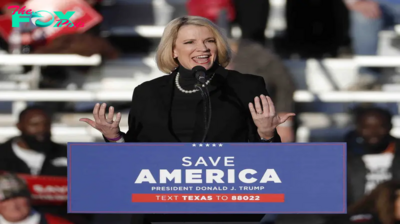US News
Do Americans Have a Constitutional Right to Use Drugs?
After decades of waging a ruinous and counterproductive war on drugs, the U.S. government is finally taking steps in a new direction.
President Biden has issued mass pardons for marijuana possession offenses and urged the Drug Enforcement Administration to reschedule pot, so that it may be legally prescribed by physicians. The Food and Drug Administration has been teeing up clinical trials for MDMA and magic mushrooms. Lawmakers from both parties have endorsed “harm reduction” strategies to combat the opioid crisis. Compared to the zero-tolerance policies of the recent past, this emerging approach to drug control is less focused on criminal punishment and more attentive to the costs and benefits of different substances and interventions.
Although few recall it now, the same basic approach almost won out a half-century ago—in the courts. Litigants brought hundreds of constitutional challenges to punitive drug laws during the 1960s and 1970s. And they secured pathbreaking rulings from federal and state judges who deemed the laws arbitrary, authoritarian, and cruel.
Almost all of those rulings were narrowed or overturned by the 1980s, paving the way for the escalation of drug penalties and militarization of drug enforcement under President Reagan and his successors. But this overlooked chapter in our constitutional History is worth revisiting. It shows how constitutional law could have denied the worst excesses of the war on drugs, instead of becoming ever more defined by them, and offers clues about how to resist draconian drug policies today.
* * *
The 1960–70s turn toward the Constitution to fight punitive drug laws was in many ways a return. Throughout the late 1800s and early 1900s, opponents of such laws challenged them in court on grounds of government overreach. Even though they increasingly approved restrictions on the manufacture and sale of intoxicants, the authorities “were unanimous in maintaining that constitutional provisions protected possession,” as one scholar observed in 1919. “[T]he inalienable rights possessed by the citizens … of seeking and pursuing their safety and happiness … would be but an empty sound,” the Kentucky Court of Appeals explained ten years earlier, “if the Legislature could prohibit the citizen the right of owning or drinking liquor.”
This legal framework fell apart in the 1910s, never to return, after a wave of prohibitory laws swept the nation and courts embraced a broader view of the government’s regulatory powers. By the mid-twentieth century, state and federal lawmakers had constitutional carte blanche to penalize drug possession and consumption as well as production and distribution. They did so with mounting severity into the 1960s.
Over the course of that decade, however, a variety of developments put the question of drug rights back into play. Surging use of illicit drugs by Vietnam veterans, students, and college-educated professionals created new constituencies for reform. Government bodies issued report after report urging relaxation of the drug laws, especially the marijuana laws, as did establishment groups ranging from the American Bar Association and the American Medical Association to the Consumers Union and the National Council of Churches.
The National Commission on Marihuana and Drug Abuse, for instance, concluded in 1972 that intermittent use of marijuana “carries minimal risk to the public Health” and recommended decriminalization. The Nixon administration’s Health department sponsored a study—blocked from publication but leaked to journalists—that found young people’s use of psychedelics can be “highly moral, productive, and personally fulfilling.” The Ford administration put out a white paper urging that drug policy be refocused on substances such as heroin that have “the highest costs to both society and the user.”
Reform-minded lawyers saw an opportunity. Building on the Warren Court’s civil liberties decisions, they began to argue that specific drug bans may violate the Constitution even if the government has expansive authority to regulate drugs in general. And many judges responded with newfound sympathy. The defendant in a low-level drug case, two Michigan justices warned in an opinion that drew national headlines, “could have been any mother’s son or daughter.”
Some judges in the 1970s held that classifying marijuana as a narcotic, or together with narcotics, is so illogical as to violate the Constitution’s Equal Protection Clause. That clause, the Supreme Court had instructed, requires criminal classifications to be at least minimally reasonable. Drawing on the latest medical research, these judges determined that lumping marijuana with the most dangerous substances fails even this minimal requirement while, in the words of the Connecticut Superior Court, “undermin[ing] a fundamental respect for the law” and imposing “staggering” social costs. Had this line of rulings prevailed, marijuana would have been removed from the most restrictive drug schedules—fifty years before President Biden’s plea to the D.E.A. to do just that.
Some judges in the 1970s argued that criminal bans on “soft drugs” violate the right to privacy implicit in the Due Process Clause. In light of the Court’s recent privacy decisions involving contraception and abortion, retired Justice Tom Clark opined in 1972 that his former colleagues “might find it difficult to uphold a prosecution for possession” of marijuana. The Alaska Supreme Court refused to uphold such a prosecution three years later, in a ruling that is still seen by international lawyers as “[t]he early land mark case on decriminalization for constitutional reasons.” Had the constitutional case for marijuana decriminalization prevailed, millions of Americans—including disproportionate numbers of Black and Brown Americans—would have been spared harassment, humiliation, and arrest at the hands of police officers looking (or claiming to look) for pot.
Some judges in the 1970s struck down criminal penalties for drug offenses as “cruel and unusual punishments” in contravention of the Eighth Amendment. After the Supreme Court held in 1962 that it is impermissibly cruel to punish people for the status of being an addict, a series of lower courts reasoned that it must likewise be cruel to punish them for procuring or consuming a drug to which they’re addicted. Other courts threw out long prison sentences for nonviolent, nontrafficking offenses as needlessly excessive. Had these decisions taken hold, harm reduction principles would have become part of our supreme law and helped check the explosion of the prison population.
Finally, some judges in the 1970s ruled that drug bans infringe the “free exercise” of religion guaranteed by the First Amendment when the drugs at issue serve a sacramental function. These rulings relied on a 1964 decision by the California Supreme Court, which protected the Native American Church’s ceremonial use of peyote. Although that decision was widely followed, judges were wary of extending it to other sects or substances. Had the effort to extend such religious exemptions succeeded, many more adults would have had legal access to the “classical psychedelics” that are now entering therapeutic practice.
By the mid-1980s, the drug war was in full swing and these constitutional arguments had faded into obscurity. They were well within the mainstream of constitutional thought in the 1970s, however. Even among the judges who rejected these arguments, a striking share not only acknowledged their force but also expressed open skepticism of the drug laws they upheld.
In defense of their decisions, these judges cited the value of judicial restraint and warned of the legal chaos that could result if they recognized too many claims of personal liberty or constitutionalized hard calls about the dangerousness of various substances. They had a point, even if they tended to overstate it. The pro-regulatory model of judicial review that liberals had championed ever since the New Deal, which demanded only a “rational basis” to justify most government measures, had not been designed to address policy failure. Many judges didn’t know what to do with a set of criminal justice and public Health policies that were themselves alleged to be criminogenic and a threat to public Health.
Constitutional rights review had been designed, instead, to respond to claims of mistreatment brought by “discrete and insular minorities,” who share a reasonably cohesive social identity. The late-twentieth-century campaigns for gay rights and gun rights fit this bill. Illicit drug users, by contrast, were not so much a discrete and insular minority as an anonymous and diffuse plurality of the population: dispersed throughout all segments of society, poorly organized, largely in the closet. No deep sense of solidarity, no identitarian glue, knit together drug users, attorneys, and activists in a coalition capable of applying sustained constitutional pressure. When the court victories dried up, the drug-rights movement collapsed.
* * *
Today’s drug reformers thus find themselves in a strange situation. There is bipartisan consensus, on the one hand, that draconian drug laws have been a travesty and, on the other, that the Constitution has nothing to say about them—even as high courts abroad have been leading the charge for drug liberalization. “Constitutional courts are increasingly ruling that the decision to use narcotic drugs or psychotropic substances falls within the scope of the moral autonomy of adults,” the Inter-American Juridical Committee of the Organization of American States noted in 2014. In democracies as diverse as Argentina, Canada, Georgia, and South Africa, constitutional protections for personal drug use are taking off. In the United States, the very idea of drug rights strikes most lawyers as outlandish.
History suggests that constitutional advocacy could still do important work, notwithstanding the progress that has been made. One role is to guard against future backsliding. American drug policy has been characterized by cycles of racialized moral panic and reactionary legislation, punctuated by periods of liberalization. Now that the country finds itself in another moment when humane, evidence-based drug reform is on the table, proponents would do well to entrench as much of it in constitutional law as they can before the next panic arrives.
Beyond trying to lock in policy gains, constitutional advocates could harness recent scholarship to attack the harshest laws still on the books. They might, for instance, draw on research into the framers’ surprisingly expansive understanding of “cruel and unusual punishment,” when they wrote the Eighth Amendment in 1791, or on a burgeoning interdisciplinary literature that depicts psychedelic drug bans as impediments to “cognitive liberty.” State courts may be especially receptive to the constitutional claims that have carried the day in other countries, about how the private burdens imposed by certain drug laws are grossly disproportionate to their public benefits.
Judicial decisions can’t solve deep-seated social problems like opioid overdose. But they can at least serve as a brake on overincarceration and force lawmakers to acknowledge when their drug policies do more harm than good.
Importantly, constitutional arguments can also be addressed to audiences other than courts. Many of the institutional considerations that have made judges reticent to wade into drug debates don’t apply to the other branches. Legislators and administrators have an independent duty to respect the rights of drug users and to reject policies that, as President Carter once put it, are “more damaging to an individual than the use of the drug itself.” In its ongoing review of marijuana’s scheduling under federal law, the D.E.A. should be forced to reckon not only with the scientific findings on medical marijuana but also with the myriad constitutional concerns raised by the government’s existing approach.
Our disastrous experience with the war on drugs invites us to recover a sense of constitutional possibility. The most effective constitutional arguments against ineffective, punitive drug laws have varied widely across eras, and they may vary again. The one constant is that such laws have always been in deep tension with some of our nation’s deepest normative commitments.
-

 US News1d ago
US News1d agoHow TIME and Statista Determined the Best Companies and Colleges for Future Leaders for 2025
-

 US News1d ago
US News1d agoWorld’s Best Brands – United States
-

 US News2d ago
US News2d agoFlorida Man Arrested and Charged With Planning to Bomb the New York Stock Exchange
-

 US News2d ago
US News2d agoU.S. Gathers Global Group to Tackle AI Safety Amid Growing National Security Concerns
-

 US News3d ago
US News3d agoTexas Offers Trump Land on U.S.-Mexico Border for Potential Mass Deportations
-

 US News3d ago
US News3d ago4B Is Not the Winning Strategy to Resist the Patriarchy People Think It Is
-

 US News3d ago
US News3d ago‘Bomb Cyclone’ Threatens Northern California and Pacific Northwest
-

 US News3d ago
US News3d agoClimate Action in Trump 2.0

















